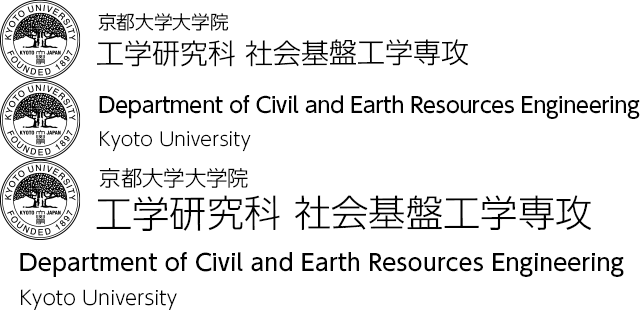Geomechanics
Geomaterials support all of the civil structures and environments as a ground. Therefore, we need to study the response of geomaterials to earthquakes, weathering, the changes of climate etc. accurately in order to build the civil structures and maintain environments safely. Furthermore, it is important to clarify the complicated soil-structure interaction and the mechanical behavior of structures. Our re-search activities focus deals on one hands with constitutive models for geomateials and on the other hand with the interaction between soil and structures through experiments and numerical analyses.
Academic Staff
Yosuke HIGO
 Professor (Graduate School of Engineering)
Professor (Graduate School of Engineering)
Research Topics
Geomaterials are multiphase mixtures of soil, water, air, and other materials, and their mechanical behavior is more complex than that of single-phase materials because it depends on the interaction between the phases. Therefore, we are investigating the relationship between the macroscopic deformation performance and strength properties of geomaterials by clarifying the structural changes of each phase from a microscopic viewpoint using X-ray CT technology. Furthermore, based on the physical background revealed by the experiments, we are developing a model that can precisely represent the deformation and fracture behavior of geomaterials, and developing a method to analyze and predict the deformation and fracture behavior of geomaterials under various external forces such as rainfall and earthquakes.
Contacts
Bldg. C1, Katsura Campus
TEL:
E-mail: higo.yohsuke.5z![]() kyoto-u.ac.jp
kyoto-u.ac.jp
Ryota HASHIMOTO
 Associate Professor (Graduate School of Engineering)
Associate Professor (Graduate School of Engineering)
Research Topics
Main research targets are development of numerical methods and their application to the following geomechanics problems.
1. Seismic stability evaluation of jointed rock slope
2. Geotechnical conservation of historic masonry structures
3. Large deformation analysis of earth structures under interaction with fluids
4. Soil-construction machinery interaction problems
Contacts
Room 581, Bldg. C1, Katsura Campus
TEL: +81-75-383-3192
E-mail: hashimoto.ryota.6e![]() kyoto-u.ac.jp
kyoto-u.ac.jp
Zirui LU
Assistant Professor (Graduate School of Engineering)
Research Topics
Engaged in the development of numerical methods, focusing on the interaction between soil/rock, fluid, and structures. Conducting large deformation analyses of seabed soil caused by the offshore wind power facilities construction using the Material Point Method (MPM). Advancing the understanding of Multiphysics phenomena and rock fracturing mechanisms through Peridynamics.
Contacts
Room 234, Bldg. C1, Katsura Campus
TEL:
E-mail: lu.zirui.2p![]() kyoto-u.ac.jp
kyoto-u.ac.jp
Research Topics
Clarification of multi-scale behaviors of geomaterials
Geomaterials are multiphase mixtures of soil, water, air and other materials, and hence the mechanical behaviour depends on the interactions between the phases. Accurate interpretation and representation of various behaviours of geomaterials require a focus on changes at the microscopic scale of the soil particle level. In current geotechnical engineering, the ground is treated as a continuum of averaged soil particle aggregates due to the signifi-cant difference in scale from the actual ground and the soil struc-ture. In our laboratory, an X-ray micro-CT technology is used to reveal the structural changes of the individual phases of geo-materials from a microscopic point of view and to study their re-lationship with the deformation and strength characteristics of geomaterials at a macroscopic level. Furthermore, constitutive models and predictive simulation methods that can precisely represent the deformation and failure behaviour of geomaterials have been developed to analyse the behaviour of natural ground and earth structures such as roads and embankments, and to assess their stability during construction and disasters such as rainfall and earthquakes.

Development of mechanical simulation techniques for geomaterials
To gain insights into the mechanisms underlying geomechanical phenomena and enhance the design techniques of secure social infrastructures and resilience against geo-disasters, numerical simulation is a powerful tool. We are actively engaged in advanc-ing numerical methods that tackle diverse challenges, including soil-structure interaction, soil-fluid interaction, and the seismic behavior of rock slopes. For example, we developed an improved Discontinuous Deformation Analysis (DDA) that enhances accu-racy and computational stability issues aiming to establish a seismic response analysis of jointed rock slopes. We are also working on the development of large deformation analysis tech-nique for earth structures using the Material Point Method.
Geotechnical conservation/restoration of historic masonry structures
We are developing a numerical analysis technique for discontinu-ities in order to clarify the mechanism of instability of masonry structures, which are cultural heritages, and to develop a stability evaluation method for them. One of the targets is the Angkor ruins, a World Heritage site in Cambodia. Many of the masonry struc-tures at Angkor are in danger of collapsing due to deformation and failure of the foundation. We consider the deformation and failure of composite structures consisting of soil and masonry as a prob-lem of mechanical interaction between a continuum and discon-tinua, and are conducting a series of research including (1) the development of an integrated mechanical analysis method for soil-masonry structures to (2) the investigation of mechanical properties of composite structures consisting of soil and masonry and (3) the proposal of a practical stability (bearing capacity) evaluation formula.
